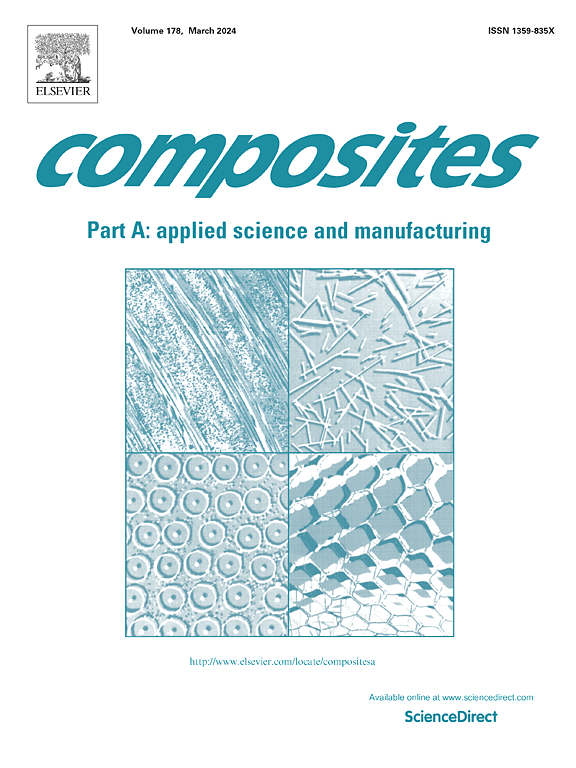刚性和延展性的3d结构金属/陶瓷复合材料
IF 8.1
2区 材料科学
Q1 ENGINEERING, MANUFACTURING
Composites Part A: Applied Science and Manufacturing
Pub Date : 2025-04-04
DOI:10.1016/j.compositesa.2025.108904
引用次数: 0
摘要
分散陶瓷增强铝复合材料的研究取得了实质性进展,但其在具有挑战性的机械环境中的广泛应用仍然受到铝固有延展性的限制。在这里,使用增材制造(AM)和气体压力渗透制备了一种新型的3d结构金属/陶瓷复合材料。这种创新的方法允许前所未有的设计灵活性,特别是在加固拓扑结构中,周期性Gyroid结构的集成显着提高了性能。3d结构的金属/陶瓷复合材料具有出色的机械性能,具有比基体高4.6倍的抗压强度。韧脆界面的存在对陶瓷的完整性起着双重作用:它不仅抑制了陶瓷的开裂,而且阻碍了裂纹的发展,从而将破坏模式从灾难性的转变为局部的和可控的。双连续结构使韧性金属由刚性陶瓷支撑,从而防止在高载荷下过度的塑性变形。因此,3d结构的金属/陶瓷复合材料的承载能力增加了一倍,而循环加载时的残余应变降低了50%。这种创新的3d结构金属/陶瓷复合材料成功地打破了结构材料在刚度和韧性之间的传统权衡,为高抗冲击应用提供了一个有前途的解决方案。本文章由计算机程序翻译,如有差异,请以英文原文为准。
Stiff and ductile 3D-architectured metal/ceramic composites
Substantial progress has been achieved in the investigation of dispersive ceramic-reinforced aluminum composites, yet their broad deployment in challenging mechanical settings remain limited by the inherent malleability of aluminum. Here, a novel 3D-architectured metal/ceramic composite was fabricated using additive manufacturing (AM) and gas pressure infiltration. This innovative approach allows for unprecedented design flexibility, particularly in the reinforcement topological architecture, where the integration of a periodic Gyroid structure significantly enhances performance capabilities. The 3D-architectured metal/ceramic composite exhibits outstanding mechanical properties, boasting a remarkable compressive strength that is 4.6 times greater than that of the matrix. The presence of a ductile–brittle interface plays a dual role in ceramic integrity: it not only suppresses ceramic cracking but also impedes the progression of cracks, thereby altering the failure mode from catastrophic to localized and manageable. The bi-continuous structure enables the ductile metal to be supported by the rigid ceramic, thereby preventing excessive plastic deformation under high loads. Consequently, the load-bearing capacity of the 3D-architectured metal/ceramic composite doubles, while the residual strain during cyclic loading decreases by 50%. This innovative 3D-architectured metal/ceramic composite successfully breaks the traditional trade-off between stiffness and toughness in structural materials, offering a promising solution for high-impact resistance applications.
求助全文
通过发布文献求助,成功后即可免费获取论文全文。
去求助
来源期刊

Composites Part A: Applied Science and Manufacturing
工程技术-材料科学:复合
CiteScore
15.20
自引率
5.70%
发文量
492
审稿时长
30 days
期刊介绍:
Composites Part A: Applied Science and Manufacturing is a comprehensive journal that publishes original research papers, review articles, case studies, short communications, and letters covering various aspects of composite materials science and technology. This includes fibrous and particulate reinforcements in polymeric, metallic, and ceramic matrices, as well as 'natural' composites like wood and biological materials. The journal addresses topics such as properties, design, and manufacture of reinforcing fibers and particles, novel architectures and concepts, multifunctional composites, advancements in fabrication and processing, manufacturing science, process modeling, experimental mechanics, microstructural characterization, interfaces, prediction and measurement of mechanical, physical, and chemical behavior, and performance in service. Additionally, articles on economic and commercial aspects, design, and case studies are welcomed. All submissions undergo rigorous peer review to ensure they contribute significantly and innovatively, maintaining high standards for content and presentation. The editorial team aims to expedite the review process for prompt publication.
 求助内容:
求助内容: 应助结果提醒方式:
应助结果提醒方式:


